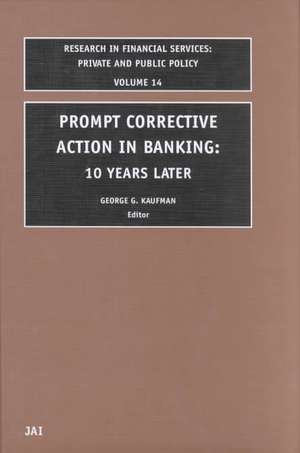Prompt Corrective Action in Banking – 10 Years Later: Research in Financial Services: Private and Public Policy
Autor G.g. Kaufmanen Limba Engleză Hardback – 14 ian 2003
FDICIA attempted to correct these flaws by reforming the deposit insurance structure through requiring regulatory prompt corrective action (PCA) and least cost resolution (LCR). PCA mandated a series of both discretionary and mandatory sanctions that the regulators first may and then must apply as an institutions's financial health progressively deteriorates as reflected in a number of capital-to-asset ratios. These sanctions are intended to encourage the institutions to reverse their deterioration before it is too late. But if they fail to do so, PCA requires resolution of the institution before their book-value capital is fully depleted. This is intended to minimize any losses from failure.
The designed PCA sanctions are modelled after the actual sanctions that the private market typically imposes on troubled firms in uninsured industries and that are distorted in banking by the government-provided insurance. Thus, FDICIA attempts to supplement regulatory and supervisory discipline with stimulated market discipline.
Since its introduction in the United States in 1991, PCA has been explicitly or implicity adopted in word if not spirit in many developed and developing countries with greatly different banking and regulatory structures. How well has it worked or could it work? The papers also consider reinforcing or alternative prudential techniques. Thus, they add to our storehouse of knowledge on improving the performance of banking systems and should prove useful to researchers, practioners, and policy-makers both in evaluating extant regulatory structures and in designing new or modified structures. All the papers were presented by the authors and commented on by the discussants at invited sessions at the annual meeting of the Western Economic Association in Seattle, Washington in July 2002. Maia Pykina (Loyola University Chicago) provided assistance both in arranging the session programs and in preparing the papers for publications.
Preț: 1125.10 lei
Preț vechi: 1461.16 lei
-23% Nou
Puncte Express: 1688
Preț estimativ în valută:
215.32€ • 222.43$ • 179.20£
215.32€ • 222.43$ • 179.20£
Carte tipărită la comandă
Livrare economică 25 martie-08 aprilie
Preluare comenzi: 021 569.72.76
Specificații
ISBN-13: 9780762309870
ISBN-10: 0762309873
Pagini: 344
Dimensiuni: 156 x 234 x 32 mm
Greutate: 0.61 kg
Editura: Emerald Publishing
Seria Research in Financial Services: Private and Public Policy
ISBN-10: 0762309873
Pagini: 344
Dimensiuni: 156 x 234 x 32 mm
Greutate: 0.61 kg
Editura: Emerald Publishing
Seria Research in Financial Services: Private and Public Policy
Cuprins
List of contributions. Introduction (G.G. Kaufman). Part I Market discipline by bank creditors. Subordinated debt and prompt corrective regulatory action (D.D Evanoff, L.D. Wall). Can feedback from the jumbo-CD market improve off-site surveillance of community banks? (R.A. Gilbert et al.). Did FDICIA enhance market discipline on community banks? (J.R. Hall et al.). Comment (B.E. Gup). Comment (A.C. Hess). Part II PCA and market discipline: The U.S. experience. The major supervisory initiatives post-FDICIA: Are they based on goals of PCA? Should they be? (R.A. Eisenbeis, L.D. Wall). Differentiating among critically undercapitalized banks and thrifts (L. Shibut, et al.). Pricing bank distress: Before and after PCA (G.A. Hanweck, L.J. Spellman). Comment (H. Rosenblum). Comment (L.R. Mote). Part III. PCA and market discipline: The non-U.S. experience. Do depositors discipline Swiss banks? (U.W. Birchler, A.M. Maechler). PCA in International practice (A. de Juan). When does financial liberalization make banks risky? An empirical examination of Argentina, Canada and Mexico (W.C. Gruben, et al.). Comment (W.C. Hunter). Comment (D.T. Llewellyn).

















